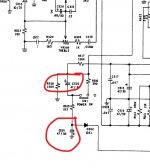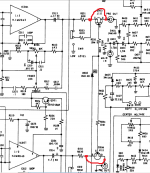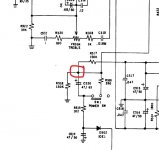Then you need to connect the generator to the “Main in” input and check the power amplifier. But you have to be very careful not to damage the speakers. There is no sound control. It is necessary to apply a signal with a small amplitude.
Then you need to connect the generator to the “Main in” input and check the power amplifier. But you have to be very careful not to damage the speakers. There is no sound control. It is necessary to apply a signal with a small amplitude.
I intend connecting an external pre-amp when I get a chance. Hopefully this will tell me if the problem is with the pre-amp section or not.
Thanks
Then you need to connect the generator to the “Main in” input and check the power amplifier. But you have to be very careful not to damage the speakers. There is no sound control. It is necessary to apply a signal with a small amplitude.
Checked switches sw4-sw9?
No, but I have made a note of your suggestion. Thanks
After connecting an external pre-amplifier to the NAD everything worked normally which suggested to me that the problem was with the intergraded pre-amplifier section. I then disconnected the pre-amplifier, replaced the links, powered up and found that the base was now present but with some distortion between the channels (that was late last night). I tried it again this morning with the hope of analysing the distortion but found that this too had disappeared. I tried all the functions and found that there is a hum on the left channel when set to Phono. This hum is not present when connected with the external pre-amplifier so there is not a problem with the tone arm grounding.
I’m not sure if any of this makes any sense to you. Could it be a capacitor?
I’m not sure if any of this makes any sense to you. Could it be a capacitor?
Very hard to say tbh.
If both channels are affected then I still keep coming back to that FET mute circuitry. That could also cause distortion if the FET's were in an indeterminate state (neither fully on or off).
These two caps derive the voltages needed for the mute so definitely worth replacing them.
The hum needs to be treated as a separate issue. Basically you start by having shorting plugs fitted to the RCA inputs for the phono stage and with nothing else connected apart from speakers you check to see if the amp is quiet and then take things from there.
If both channels are affected then I still keep coming back to that FET mute circuitry. That could also cause distortion if the FET's were in an indeterminate state (neither fully on or off).
These two caps derive the voltages needed for the mute so definitely worth replacing them.
The hum needs to be treated as a separate issue. Basically you start by having shorting plugs fitted to the RCA inputs for the phono stage and with nothing else connected apart from speakers you check to see if the amp is quiet and then take things from there.
Attachments
Very hard to say tbh.
If both channels are affected then I still keep coming back to that FET mute circuitry. That could also cause distortion if the FET's were in an indeterminate state (neither fully on or off).
These two caps derive the voltages needed for the mute so definitely worth replacing them.
The hum needs to be treated as a separate issue. Basically you start by having shorting plugs fitted to the RCA inputs for the phono stage and with nothing else connected apart from speakers you check to see if the amp is quiet and then take things from there.
Is this the item?RCA Shorting Plugs | Hifi Collective
Those plugs have a 5 k resistor, which is close enough to a short. Another way to short the inputs is solder a wire across the solder pads on the circuit board.
Is this the item?RCA Shorting Plugs | Hifi Collective
Kind of 🙂 its as TBTL says... just short them out directly.
An old phono lead with the wires chopped off close to the plugs would do nicely. Just short the inner and outer conductors on each wire together.
Kind of 🙂 its as TBTL says... just short them out directly.
An old phono lead with the wires chopped off close to the plugs would do nicely. Just short the inner and outer conductors on each wire together.
Shorting the phono has cut the hum, just becomes audible now at about 50% volume
Connect S and D (Q303, Q304) if you are friends with a soldering iron.
Done that but it hasn't made any difference. As I mentioned in an earlier post today, the original problem seems to have righted itself. It seems that the hum on phono is a separate issue now.
Shorting the phono has cut the hum, just becomes audible now at about 50% volume
The hum level you hear now is probably as good as it gets for this amp (assuming there isn't some other fault which is unlikely). This means that any increase in hum you get as you connect a TT is being introduced externally... it has to be.
You can try connecting the TT (but do not connect the TT to the mains) and see if the hum increases. If it does then it is via stray pickup
If the hum is a deep pure tone that only appears when mains is applied then it's likely to be a ground loop of some sort introduced by circulating currents in the mains ground connections of the various units.
Done that but it hasn't made any difference. As I mentioned in an earlier post today, the original problem seems to have righted itself. It seems that the hum on phono is a separate issue now.
If the amp is working normally at the moment then this test won't prove anything. This was the test I asked you to do back in post #16:
You can also try shorting out Drain and Source of either of the FET's and see if the audio then appears normally.
I've just managed to fix the hum, dry joint on the board.he hum level you hear now is probably as good as it gets for this amp (assuming there isn't some other fault which is unlikely). This means that any increase in hum you get as you connect a TT is being introduced externally... it has to be.
You can try connecting the TT (but do not connect the TT to the mains) and see if the hum increases. If it does then it is via stray pickup
If the hum is a deep pure tone that only appears when mains is applied then it's likely to be a ground loop of some sort introduced by circulating currents in the mains ground connections of the various units. #16:
There is still some distortion on the left channel. Bit difficult to describe, vocals don't sound clear a bit like a slight gargle?
Going to be busy with other things for next few days. Will provide an update then when I have more time to mess with it. Thanks again.
Last edited:
So is the amp fully quiet now? and quiet when all coupled up.
It's always difficult trying to gauge faults just from descriptions of how they sound 🙂
It's always difficult trying to gauge faults just from descriptions of how they sound 🙂
So is the amp fully quiet now? and quiet when all coupled up.
It's always difficult trying to gauge faults just from descriptions of how they sound 🙂
I’ve just realised that the distortion on the left channel is only present after the removal of the links to Q303 and Q304. When I reported back that all was now ‘normal’ I can’t say that I heard any distortion at that time. It was only after I removed the links tonight that I sensed that there was still something amiss; so I refitted them and the distortion disappeared! What does this now mean? Do the J111 need replacing?
Do the J111 need replacing?
I would delete them. They only spoil the sound.
I’ve just realised that the distortion on the left channel is only present after the removal of the links to Q303 and Q304. When I reported back that all was now ‘normal’ I can’t say that I heard any distortion at that time. It was only after I removed the links tonight that I sensed that there was still something amiss; so I refitted them and the distortion disappeared! What does this now mean? Do the J111 need replacing?
First have a measure of the DC voltage on C520 as shown here. The voltage at this point is the control voltage for the FET's and should be a positive voltage.
The actual voltage you see should be one half of the value of the supply rail produced by regulator Q501 and that looks like it will be in the positive 20 to 24 volt region. It will be one half because of the two 150k resistors forming a simple voltage divider.
So you should be seeing around positive 10 to 12 volts on C520. We need to know that voltage... but remember if the amp is variable in its fault (sometimes working and sometimes not) then this voltage may seem to alter.
This positive voltage biases the FET's on fully and allows them to pass the audio.
The above condition is the normal state of play in normal operation.
Now look at C519 and D502 on the circuit diagram. These derive a negative voltage supply that can be used to over ride the FET's normal control voltage.
When we take the control voltage lower toward zero volts and then pass through to a negative voltage then the FET's turn OFF and mute the audio.
The control voltage can be taken lower by the action of C520 'charging up' for a brief moment and also by the action of that third contact on the mains switch.
There are three realistic scenarios for problems here.
1/ Those two electrolytic caps. They are actually quite highly stressed and C519 in particular a prime candidate for deterioration and failure. You can't second guess or easily test them. Caps fail in subtle ways that a quick check of value and even E.S.R. will not always show.
2/ The mains switch itself could be an issue. If the third contact has leakage between the poles or sometimes sticks then it will apply this negative voltage to the FET's and cause them to mute.
3/ Finally the 150k resistors. High value resistors used across high voltage rails (although thb the voltages here aren't really high but still...) can fail by going high in value. This happens even though the resistor is well within its dissipation limits. If R517 was high then the FET control voltage would be lower than it should be which would cause the FET's not to be fully on.
If the control voltage for the FET is to low then the behaves in a non linear way and it will create distortion, a distortion that varies with the amplitude of the signal.
Attachments
- Home
- Amplifiers
- Solid State
- No bass sound



